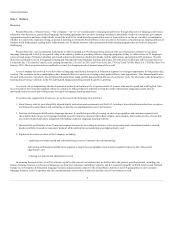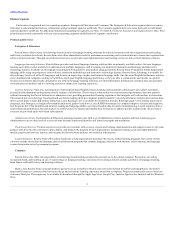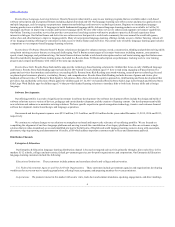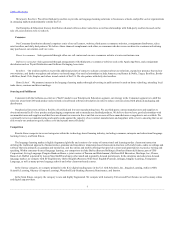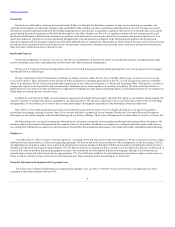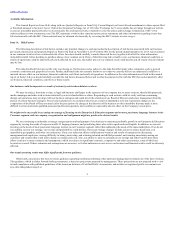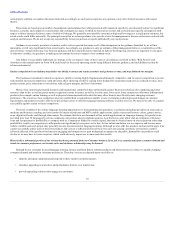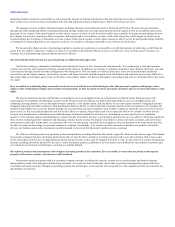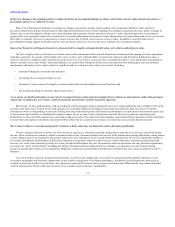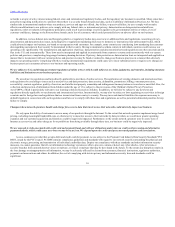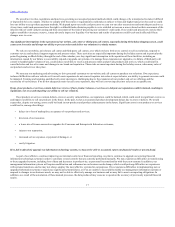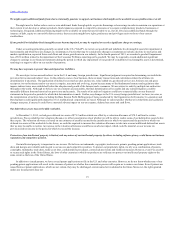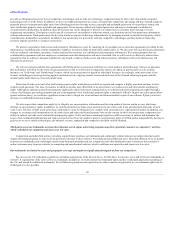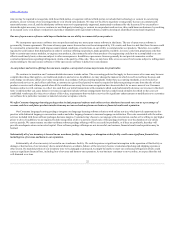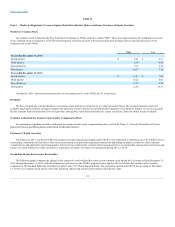Rosetta Stone 2015 Annual Report Download - page 15
Download and view the complete annual report
Please find page 15 of the 2015 Rosetta Stone annual report below. You can navigate through the pages in the report by either clicking on the pages listed below, or by using the keyword search tool below to find specific information within the annual report.
Table of Contents
If there are changes in the spending policies or budget priorities for government funding of colleges, universities, schools, other education providers, or
government agencies, we could lose revenue.
Many of our Enterprise & Education customers are colleges, universities, primary and secondary schools and school districts, other education
providers, armed forces and government agencies that depend substantially on government funding. Accordingly, any general decrease, delay or change in
federal, state or local funding for colleges, universities, primary and secondary schools and school districts, or other education providers or government
agencies that use our products and services could cause our current and potential customers to reduce their purchases of our products and services, to exercise
their right to terminate licenses, or to decide not to renew licenses, any of which could cause us to lose revenue. In addition, a specific reduction in
governmental funding support for products such as ours would also cause us to lose revenue and could hurt our overall gross margins.
Some of our Enterprise & Education business is characterized by a lengthy and unpredictable sales cycle, which could delay new sales.
We face a lengthy sales cycle between our initial contact with some potential Enterprise & Education customers and the signing of license agreements
with these customers. As a result of this lengthy sales cycle, we have only a limited ability to forecast the timing of such Enterprise & Education sales. A
delay in or failure to complete license transactions could cause us to lose revenue, and could cause our financial results to vary significantly from quarter to
quarter. Our sales cycle varies widely, reflecting differences in our potential Enterprise & Education customers' decision-making processes, procurement
requirements and budget cycles, and is subject to significant risks over which we have little or no control, including:
• customers' budgetary constraints and priorities;
• the timing of our customers' budget cycles;
• the need by some customers for lengthy evaluations that often include administrators and faculties; and
• the length and timing of customers' approval processes.
As we pursue our SaaS model and move more of our Consumer business online and increasingly sell our solutions as subscriptions, rather than packaged
software for an upfront fee, our revenue, results of operations and cash flow could be negatively impacted.
Historically, we have predominantly sold our packaged software programs under a perpetual license for a single upfront fee and recorded 65-90% of the
revenue at the time of sale. Certain of our online products are sold under different subscription terms, from short-term (less than one year) to 36-month
subscriptions with a corresponding license term. Selling more long-term subscriptions could result in substantially less cash and revenue from the initial sale
to the customer and could have a substantially negative impact on our revenue, results of operations and cash flow in any quarterly reporting period.
Furthermore, to the extent that customers use our products and services for only a short time after purchase, online subscription customers could be less likely
to renew their subscriptions beyond the initial term with the effect that we could earn less revenue over time from each customer than historically.
Our revenue is subject to seasonal and quarterly variations, which could cause our financial results to fluctuate significantly.
We have experienced, and we believe we will continue to experience, substantial seasonal and quarterly variations in our revenue, cash flows and net
income. These variations are primarily related to increased sales of our Consumer products and services in the fourth quarter during the holiday selling season
as well as higher sales to governmental, educational institutions, and corporations in the second half of the calendar year. We sell to a significant number of
our retailers, distributors and Enterprise & Education customers on a purchase order basis and we receive orders when these customers need products and
services. As a result, their orders are typically not evenly distributed throughout the year. Our quarterly results of operations also may fluctuate significantly
as a result of a variety of other factors, including the timing of holidays and advertising initiatives, changes in our products, services and advertising
initiatives and changes in those of our competitors. Budgetary constraints of our Enterprise & Education customers may also cause our quarterly results to
fluctuate.
As a result of these seasonal and quarterly fluctuations, we believe that comparisons of our results of operations between different quarters are not
necessarily meaningful and that these comparisons are not reliable as indicators of our future performance. In addition, these fluctuations could result in
volatility and adversely affect our cash flows. Any seasonal or quarterly fluctuations that we report in the future may differ from the expectations of market
analysts and investors, which could cause the price of our common stock to fluctuate significantly.
14


